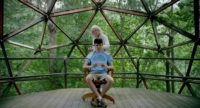Movies are a classic escape, which is why last week, in the aftermath of the contentious presidential election, it was no surprise that more than 350 people crowded into a darkened auditorium at Los Angeles’ Skirball Cultural Center for some respite, and perhaps a little inspiration.
Visitors were there to experience a sold-out screening of The Love Song of R. Buckminster Fuller, a “live documentary” on the life of the renowned utopian architect and inventor. Created by Oscar-nominated documentary director Sam Green, the film is a hybrid art form: Green narrated the film while indie rock band Yo La Tengo played in the background.
An unusual movie going experience, yes, but one that Netflix could never replicate. The film began with one of Fuller’s geodesic domes being lifted into the air by a helicopter a tarp over its its spherical frame fluttering in the wind. The dome moved like a graceful dancer, gliding across the screen. The images were accompanied by Yo La Tengo’s light, tinkling music.
No performance is ever the same, says Green. In this Los Angeles run, the director weaved in a few of Fuller’s Los Angeles moments: a talk he gave at the local Mensa (the high IQ society); his final home address in the Pacific Palisades; and also one of his last installations, the Fly’s Eye dome, set right on Pershing Square.
As Green dipped viewers into different stages of Fuller’s life—from the tragedy of his daughter’s death to his professional apex on the cover of Time magazine—the audience gradually formed an idea of this grandfather of the Space Age that surpasses his signature thick-rimmed glasses and geodesic domes.
Apart from the highlights of Fuller’s life, Green treats the viewers to the minutia as well—a peek into his family photos, a glimpse of his passport pages, and even a shot of his social security card. All the while, Yo La Tengo’s music wafted in and out, an auditory paintbrush coloring the images on screen. At times, it is light, sweet, and hopeful. In others, it is dark and somber.
Throughout the hour-long performance, Green deftly elicited emotions from his audience: a laugh here, a sigh there. By the end, the director and narrator became that cultured friend you wish you had sitting beside you at every event.
As the lights came up and the last images of Fuller’s gravestone faded, the architect’s voice still lingered, as did his unwavering conviction that we can do more with less if we are only inventive enough to harness our resources. And in today’s political and economic climate, Fuller’s message seems a timely reminder to get to work and to remain hopeful.













Post a comment to this article
Report Abusive Comment